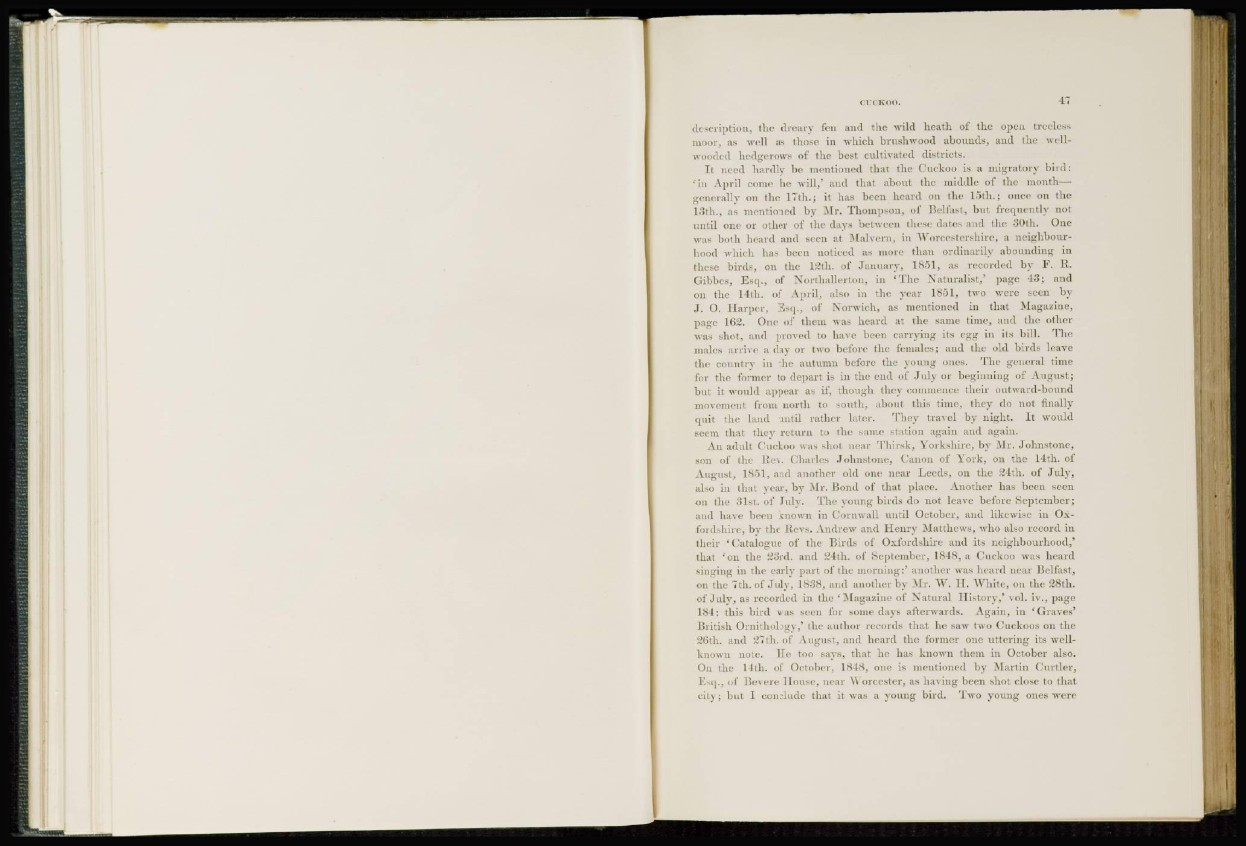
description, tlie dreary fen and the wild heath of the open treeless
moor, as well as those in which brushwood abounds, and the wellwooded
hedgerows of the best cultivated districts.
It need hardly be mentioned that the Cuckoo is a migratory bird:
'in April come he will,' and that about the middle of the month—
generally on the 17th.; it has been heard on the 15th.; once on the
13th., as mentioned by Mr. Thompson, of Belfast, hut frequently not
until one or other of the days between these dates and the 30th. One
was both heard and seen at Malvern, in AVoreestershire, a neighbourhood
which has been noticed as mine than ordinarily abounding in
these birds, on the 12th. of January, 1851, as recorded by F. II.
Gibbes, Esq., of Northallerton, in 'The Naturalist,' page 43; and
on the 14th. of April, also in the year 1851, two were seen by
J. O. Harper, Esq., of Norwich, as mentioned in that Magazine,
page 162. One of them was heard at the same time, and the other
was shot, and proved to have been carrying its egg in its bill. The
males arrive a day or two before the females; and the old birds leave
the country in the autumn before the young ones. The general time
for the former to depart is in the end of July or beginning of August;
but it would appear as if, though they commence their outward-bound
movemenl from north to south, about this lime, they do not finally
quit the land until rather later. They travel by night. It would
seem that they return to the same station again and again.
An adult Cuckoo was shot near Thirsk, Yorkshire, by Mr, Johnstone,
son of the Rev. Charles Johnstone, Canon of York, on the 14th. of
August, 1851, and another old one near Leeds, on the 24th. of July,
also in that year, by Mr. Bond of that place. Another has been seen
on the 31st. of July. The young birds do not leave before September;
and have been known in Cornwall until October, and likewise in Oxfordshire,
by the Kevs. Andrew and Henry Matthews, wdio also record in
their 'Catalogue of the Birds of Oxfordshire and its neighbourhood,'
that 'on the 23rd. and 24th. of September, 1848, a Cuckoo was heard
singing in the early part of the morning:' another was heard near Belfast,
on the 7th. of July, 1838, and another by Mr. W. H. White, on the 28th.
of July, as recorded in the 'Magazine of Natural History,' vol. iv., page
184: this bird was seen for some days afterwards. Again, in 'Graves'
British Ornithology,' the author records that he saw two Cuckoos on the
2Gth. and 27th. of August, and heard the former one uttering its wellknown
note. He too says, that In; has known them in October also.
On the 14th. of October, 1848, one is mentioned by Martin Curtler,
Esq., of Bevere House, near \\ orcester, as having been shot close to that
city; but I conclude that it was a young bird. Two young ones were